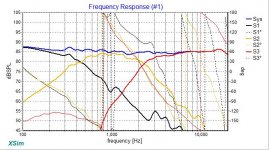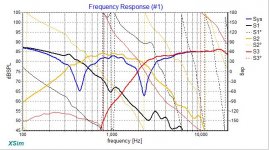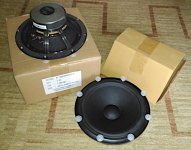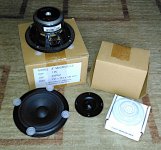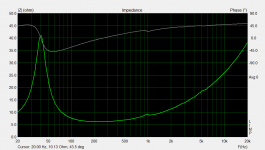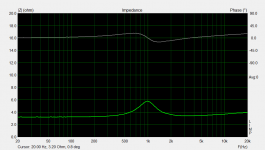With the success of my last design, a 3-way in the “classic” format (https://www.diyaudio.com/forums/multi-way/365119-soreta-3-classic-monacor-dayton-audio.html#post6493033), I started to think that I could replicate such a design with inexpensive but good performance drivers. The main problem with this statement is the availability of an inexpensive 8” driver with good bass performance and with low volume requirement. However my dreams came true with the availability of the PFC family of drivers from SB Acoustics, and specifically when SBA made them available also with a round frame.
I have yet to test the drivers but I have settled on the SB20PFCR30-8 for the bass. It should work reasonably well in my intended cab, even if some more volume would be preferred.
For the mid I was undecided for some time, and my first choice was the SB13PFCR25-4. But when drawing a sketch of the cab, I realized that in order to lay reasonably the drivers on the baffle and to make the mid enclosure not interfere with the bass I’d have needed to make a taller baffle than what I was thinking of. So I bought the 4” SB12PFCR25-4 instead, on the datasheet it appears to be sensitive just enough to mate well with the woofer.
The chosen tweeter is the SB26STCN-C000-4, I know that some other not expensive SBA tweeters have a small bit better performance, but for this application I prefer a small faceplate tweeter, and this forced my decision. And this tweeter should sustain well a planned 2.5 KHz crossover point.
In any case cost for the drivers for both speakers was around 170 Euro, and this fully qualify the SB(acoustics)INEX(pensive) name. Let we see what comes with the crossover.
Ralf
I have yet to test the drivers but I have settled on the SB20PFCR30-8 for the bass. It should work reasonably well in my intended cab, even if some more volume would be preferred.
For the mid I was undecided for some time, and my first choice was the SB13PFCR25-4. But when drawing a sketch of the cab, I realized that in order to lay reasonably the drivers on the baffle and to make the mid enclosure not interfere with the bass I’d have needed to make a taller baffle than what I was thinking of. So I bought the 4” SB12PFCR25-4 instead, on the datasheet it appears to be sensitive just enough to mate well with the woofer.
The chosen tweeter is the SB26STCN-C000-4, I know that some other not expensive SBA tweeters have a small bit better performance, but for this application I prefer a small faceplate tweeter, and this forced my decision. And this tweeter should sustain well a planned 2.5 KHz crossover point.
In any case cost for the drivers for both speakers was around 170 Euro, and this fully qualify the SB(acoustics)INEX(pensive) name. Let we see what comes with the crossover.
Ralf
This is a cool project. I always thought the PFC series of drivers looked like a great value.
The total driver cost for two speakers is 170 Euro, that is outstanding.
Something I have wondered about for a while: Will a well-designed 3-way with modestly priced drivers outperform a well-designed 2-way with higher priced drivers? I suspect the answer is yes, but you are about to find out 🙂
The total driver cost for two speakers is 170 Euro, that is outstanding.
Something I have wondered about for a while: Will a well-designed 3-way with modestly priced drivers outperform a well-designed 2-way with higher priced drivers? I suspect the answer is yes, but you are about to find out 🙂
I can't be the judge of my projects, but I also suspect the same. After all, the great point of a 3-way it that the mid does only the mid. In a 2-way the mid-bass does the mid while reproducing with higher excursions also the bass. No matter how high performance the mid-bass is, mixing bass and mid will affect the mid.
Ralf
Ralf
First simulation
Before ordering the drivers, I made some simulations based on published curves, modified based on the intended baffle/enclosure. So the following graphs have baffle step, diffraction, bass performance and relative driver offset already taken into account. I expect some discrepancies with real measures, but not too much unless the drivers measure very differently than specs.
This is what I expect with a non complicated crossover (LR2 slopes between bass and mid, and LR4 slopes between mid and tweeter):

And this is with the reversed mid, showing crossover points:

I have yet to break in the drivers, and then we will see how they measure.
Ralf
Before ordering the drivers, I made some simulations based on published curves, modified based on the intended baffle/enclosure. So the following graphs have baffle step, diffraction, bass performance and relative driver offset already taken into account. I expect some discrepancies with real measures, but not too much unless the drivers measure very differently than specs.
This is what I expect with a non complicated crossover (LR2 slopes between bass and mid, and LR4 slopes between mid and tweeter):
And this is with the reversed mid, showing crossover points:
I have yet to break in the drivers, and then we will see how they measure.
Ralf
Attachments
Hi Ralf
I've used the 'square' version of the SB16 in a two way and it sounds really nice, you're lucky you can get the round version of these drivers now. The other drivers in that series are well liked, too.
This looks a really interesting project and an affordable one here (Oz) too, good luck!
Something like this?
U_Do 4 | Audio design, Speaker design, Diy speakers
We're still enjoying your Peerless/Vifa bookshelf speakers, too.
Cheers
Geoff
I've used the 'square' version of the SB16 in a two way and it sounds really nice, you're lucky you can get the round version of these drivers now. The other drivers in that series are well liked, too.
This looks a really interesting project and an affordable one here (Oz) too, good luck!
Something like this?
U_Do 4 | Audio design, Speaker design, Diy speakers
We're still enjoying your Peerless/Vifa bookshelf speakers, too.
Cheers
Geoff
Are you thinking tower shape, stand-mount monitor shape, or something else?
I was thinking of the same cab as my other 3-way I referenced in the first post, a 3-way "classic", some 28x60 cm baffle, roughly 38 cm deep cab, so a big stand mount speaker. I don't have a facility to build a tower, but this design can probably be easily transformed into a tower with the same baffle width, adding some 40 cm under the intended baffle, for a higher volume and greater bass extension.
For sure I'll use the test cab I made for the previous project as a quick way to measure FR, even if I need to reroute the holes.
Ralf
I've used the 'square' version of the SB16 in a two way and it sounds really nice, you're lucky you can get the round version of these drivers now. The other drivers in that series are well liked, too.
This looks a really interesting project and an affordable one here (Oz) too, good luck!
Something like this?
U_Do 4 | Audio design, Speaker design, Diy speakers
Non round frames are too difficult to countersink, at least for me, so I pass away those drivers. Yes, I'm very happy to have now the round frame PFC drivers.
As for the speakers I intend to build, refer to my previous post, but I'm sure it can be adapted to a tower like the one you posted, but I won't place mid and tweeter in the middle of the baffle.
Ralf
I gave up trying to countersink the SB16s, it was a real pain. I surface mounted and there don't seem to be any ill effects, but then I didn't have anything with which to compare them.
I used them in a MLTL cabinet with the VIFA BC25 and they sound very nice, although they won't play that loud.
Looking forward to more details!
Geoff
I used them in a MLTL cabinet with the VIFA BC25 and they sound very nice, although they won't play that loud.
Looking forward to more details!
Geoff
There is no ill effect to not countersink a woofer, apart the look.
For a tweeter this is another story, you have to.
Ralf
For a tweeter this is another story, you have to.
Ralf
Hi,
Did you consider the 4" co-axial PFC for this project?
I thought this would be a great implementation your case, since you are constrained in face space and your 4" is not going to vibrate that much.
Oon
Did you consider the 4" co-axial PFC for this project?
I thought this would be a great implementation your case, since you are constrained in face space and your 4" is not going to vibrate that much.
Oon
The drivers
I’m very impressed by the build quality of the drivers and also by the packaging. Apart the use of plastic for the frame, the mid and woofer look very well build, and there is nothing that calls for cheap in them. A beautiful natural fiber cone with rubber surround, the terminals appear to be solid, positive clearly marked and bigger than negative, and there is also a gasket. The mid has a hole in the back for venting, while the woofer has not, but it seems that the voice coil is well ventilated under the spider.
The packaging is not what I expected from this price point, both mid and woofer arrived packaged in the classic trapezoidal cardboard, but with lateral wings, which was inside singularly in a cardboard box. The cardboard used is thick and solid, and I feel the drivers are very well protected. I’ve seen more clumsy packaging for higher priced drivers.
A photo of the woofers:

And a photo of the mids with a tweeter:

Before measuring the FR of the drivers (I need to build new baffle for my test box), I wanted to share at least the measurement of the impedance. My method for doing this is not the correct one, which is to clamp the drivers in free air. The method I found in the past that gives me a pretty right impedance to use in crossover simulation is to firmly press the back of a driver against the floor with some bluetack in between. In this way the driver doesn’t move when measured. If I see some anomalies, I just clamp the driver with my hands and see if the anomalies go away. If they go away then usually it means that it was a reflection from the floor. No problems however with this set of drivers.
Impedance of the woofer:

Fs is a little bit higher than specs, but otherwise the profile is pretty consistent with specs. However I need to measure T/S parameters to see if the intended cab is still a good choice.
Impedance of the mid:

Here Fs is 20Hz higher than expected, but otherwise the profile is pretty identical with specs.
Impedance of the tweeter:

Here I don’t see any significant difference from the datasheet.
Ralf
I’m very impressed by the build quality of the drivers and also by the packaging. Apart the use of plastic for the frame, the mid and woofer look very well build, and there is nothing that calls for cheap in them. A beautiful natural fiber cone with rubber surround, the terminals appear to be solid, positive clearly marked and bigger than negative, and there is also a gasket. The mid has a hole in the back for venting, while the woofer has not, but it seems that the voice coil is well ventilated under the spider.
The packaging is not what I expected from this price point, both mid and woofer arrived packaged in the classic trapezoidal cardboard, but with lateral wings, which was inside singularly in a cardboard box. The cardboard used is thick and solid, and I feel the drivers are very well protected. I’ve seen more clumsy packaging for higher priced drivers.
A photo of the woofers:
And a photo of the mids with a tweeter:
Before measuring the FR of the drivers (I need to build new baffle for my test box), I wanted to share at least the measurement of the impedance. My method for doing this is not the correct one, which is to clamp the drivers in free air. The method I found in the past that gives me a pretty right impedance to use in crossover simulation is to firmly press the back of a driver against the floor with some bluetack in between. In this way the driver doesn’t move when measured. If I see some anomalies, I just clamp the driver with my hands and see if the anomalies go away. If they go away then usually it means that it was a reflection from the floor. No problems however with this set of drivers.
Impedance of the woofer:
Fs is a little bit higher than specs, but otherwise the profile is pretty consistent with specs. However I need to measure T/S parameters to see if the intended cab is still a good choice.
Impedance of the mid:
Here Fs is 20Hz higher than expected, but otherwise the profile is pretty identical with specs.
Impedance of the tweeter:
Here I don’t see any significant difference from the datasheet.
Ralf
Attachments
I assume the SB20 and SB12 have a similar 'house' sound to the SB16, in which case they should be pretty nice. I found the SB16 to sound very similar to the Peerless SDS 6.5" woofer, which itself is very good, especially considering the modest damage. The SB is perhaps a little more detailed.
I haven't heard the SB tweeter but they have an excellent reputation.
If I could justify another pair of speakers I'd like to try a 'WAW' with the SB20 and a VIFA TC7. One day!
Good luck with your project!
Geoff
I haven't heard the SB tweeter but they have an excellent reputation.
If I could justify another pair of speakers I'd like to try a 'WAW' with the SB20 and a VIFA TC7. One day!
Good luck with your project!
Geoff
Care to share how the project went? I'm looking at those same drivers now.The drivers
I’m very impressed by the build quality of the drivers and also by the packaging. Apart the use of plastic for the frame, the mid and woofer look very well build, and there is nothing that calls for cheap in them. A beautiful natural fiber cone with rubber surround, the terminals appear to be solid, positive clearly marked and bigger than negative, and there is also a gasket. The mid has a hole in the back for venting, while the woofer has not, but it seems that the voice coil is well ventilated under the spider.
The packaging is not what I expected from this price point, both mid and woofer arrived packaged in the classic trapezoidal cardboard, but with lateral wings, which was inside singularly in a cardboard box. The cardboard used is thick and solid, and I feel the drivers are very well protected. I’ve seen more clumsy packaging for higher priced drivers.
A photo of the woofers:

And a photo of the mids with a tweeter:

Before measuring the FR of the drivers (I need to build new baffle for my test box), I wanted to share at least the measurement of the impedance. My method for doing this is not the correct one, which is to clamp the drivers in free air. The method I found in the past that gives me a pretty right impedance to use in crossover simulation is to firmly press the back of a driver against the floor with some bluetack in between. In this way the driver doesn’t move when measured. If I see some anomalies, I just clamp the driver with my hands and see if the anomalies go away. If they go away then usually it means that it was a reflection from the floor. No problems however with this set of drivers.
Impedance of the woofer:

Fs is a little bit higher than specs, but otherwise the profile is pretty consistent with specs. However I need to measure T/S parameters to see if the intended cab is still a good choice.
Impedance of the mid:

Here Fs is 20Hz higher than expected, but otherwise the profile is pretty identical with specs.
Impedance of the tweeter:

Here I don’t see any significant difference from the datasheet.
Ralf
The tweeters are very nice. Copper in the VC gap, good xmax, no ferrofluid, linear response, high efficiency and clean CSD.
This project is on hold, however I have 3 weeks in August almost free for doing something substantial on it. So stay tuned!Care to share how the project went? I'm looking at those same drivers now.
Ralf
I know this is a year old but did you ever finish this project? I'm interested in the responses you got from the PFC family
- Home
- Loudspeakers
- Multi-Way
- Sbinex – An inexpensive SB Acoustics 3-way
